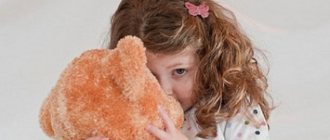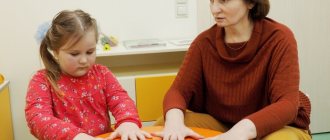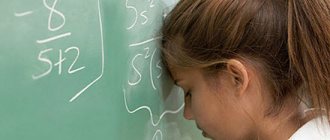.
In modern life, adverse events can easily harm the psyche of children. They develop fears. The diagnosis of children's fears allows us to timely identify the problem and get rid of it.
Childhood fears
Unidentified fear can have both hidden and extreme forms of expression, characterized by a protracted course. All this affects the development of personality, the formation of character and the determination of social roles.
The origin of fears in preschoolers
For various reasons, preschool children become the most susceptible to adverse factors. The number of children with signs of emotional distress is increasing. They become excitable, anxious or aggressive.
The origin of fears can be different. Some of them are observed due to problems and difficulties in the preschooler’s relationship with his parents or with peers. Others may be related to personal experiences. Psychologists believe that the formation of phobic disorders has 2 main theories of origin, which unite all the causes of occurrence.
The first theory is a traumatic factor, the second is a consequence of the threat of repetition of this factor. The characteristics of the mental development of children depend on the reality of the threat after experiencing stressful situations, which resulted in the formation of a fear of a certain stimulus. Affectively heightened perception of danger is part of the defense mechanism. Those children who suffer from fears change their own behavior and react differently emotionally.
Immunity to fears, that is, the absence of an impact on the psyche, is observed very rarely. Psychologists are sure that this is unnatural for the normal development of children. Such problems may indicate problems with expressing emotions, excessive excitability, and even weak self-preservation instincts.
DIAGNOSIS AND CORRECTION OF CHILDREN'S FEARS
A psychologist diagnoses children's fears to identify the cause that caused them. After all, only by finding and eradicating it can you win this fight.
Depending on the child’s age, inclinations, and skills, he may be offered:
- draw something on a given or arbitrary topic (the psychologist looks at colors, sizes, arrangement of parts of the drawing, plot, clarity of lines and details, etc.);
- sculpt something - according to the same principle;
- come up with a fairy tale (or finish the one proposed);
- have an open conversation about the problem (for this, the adult must first inspire confidence in the child).
After this, corrective work with the baby is necessary to solve the problem. It may require from 3 to several dozen sessions. Correction is carried out in various forms - depending on the inclinations of the child himself, his age, the degree of neglect of the case, etc.:
- Fairytale therapy. Experiencing the plot of specially selected fairy tales, the child feels brave, strong, and learns to overcome emotional stress.
- Play therapy. The game immerses the child in a traumatic environment in an imaginary world. This way the fear looks much weaker and is easier to correct further.
- Drawing. The kid draws his fear, examines it with the help of a psychologist to the smallest detail, makes it funny, destroys it.
In each specific case, these techniques can be supplemented by others:
- dance therapy;
- aromatherapy;
- music therapy;
- uvetotherapy;
- art therapy;
- sand therapy, etc.
The emergence of fears in a child is an inevitable sign of his development. But when they take on stable, obsessive forms and interfere with full development, rest, and self-realization, adults should come to the rescue: parents or psychologists. And often correctional work requires considerable effort from both. But our children's mental health is worth it.
Features of fears in preschoolers
The emergence of fears is directly related to the pathogenesis of the development of neuroses in children and adolescents. It is important to understand the features of their diagnosis. Assessing the actions of irritating factors, as well as the influence of these processes on the formation of personality, will help bring the psyche back to normal. Without knowledge about the age-related dynamics of such problems, the correction of fears will not be effective. It is also important that the appearance of phobic disorders is characterized differently in boys and girls.
Psychologist A.I. Zakharov in his works pointed out the following features of the development of anxiety in preschool children:
- Fears occur more often in girls than in boys between the ages of 3 and 15 years.
- Girls and boys have different natures and directions of fears.
- Boys hide their own anxiety about fears more than girls.
A favorable attitude towards children from parents and social groups and other signs of normalization of life circumstances can lead to them overcoming their fears on their own. Problems disappear with age, but not always. Some are subject to difficulties in personal development, have difficulty adapting, or experience neurotic disorders.
A. Zakharov proposed a system for distributing fears by gender and year, enclosing them in certain characteristics. In total, the scientist’s work described 28 variants of phobias. More than half of them are allocated for preschoolers.
FEATURES OF FEARS
Children express their fears in different ways, depending on their age and emotional development. This could be severe fear, constant fear of something, or affective fear - arising against the background of emotional instability. It is the most powerful and can manifest itself in the form of shock, horror, and hysterical crying.
A child may complain to adults that he is afraid of something, or he may keep everything to himself (especially if he is afraid of being misunderstood, of hearing reproaches, ridicule and condemnation). But alarming symptoms will still be present. The baby becomes fearful, withdrawn, nervous, apathetic, may have difficulty falling asleep or sleep lightly, and will constantly cling to his mother.
Hidden anxiety that does not find a way out or understanding is the most dangerous for the delicate child’s psyche. It is this that most often leads to the appearance of lingering fear, which is beyond the baby’s control. This leaves an imprint on the formation of the child’s character, prevents productive communication with others, and reduces adaptability to changes in the external environment. Ultimately, chronic fears affect the child’s future: his socialization, relationships with the opposite sex, and colleagues at work.
Common types of fears in children
Zakharov’s theories about the peculiarities of the formation of phobic disorders in children are still used by specialists today. According to his classification, preschoolers are classified with 12 to 15 different types of fear. The most common ones are:
- fear of parental death;
- fear of strangers;
- fear of the dark;
- night terrors;
- fear of water, fire or heights;
- fears of cats, dogs or other animals.
No less common are fear of parents, fear of being punished, or fear of doctors and injections. There are many options. A qualified specialist, when starting to correct the fears of preschool children, is obliged to study the clinical picture of the patient.
Night terrors in children
The work involves the use of special techniques, the objectives of which are based on creating a trusting relationship with the patient with inherent emotional contact.
To identify fears, it is important to use a ready-made, proven diagnostic model using special questionnaires or games.
THE POWER OF IMAGINATION
Separately, it is worth mentioning the role of fantasy in perpetuating fears in children. Prolonged experience of fears, their transition into phobias is typical for children who are anxious, suspicious, unconfident, impressionable, pessimistic, dependent and susceptible to influence. It is in such cases that innocent childhood fantasies quickly acquire obsessive chronic features.
And children, especially in preschool age, fantasize for any reason (this is a natural stage of their psychological development): heard a scary fairy tale or horror story from a peer, watched a scary cartoon or movie, read a book with a terrible plot, played a bloody computer game, heard something in the conversation of adults. Even cats fighting in the yard can cause fear.
A developed imagination works continuously. Frightening shadows from a lamp, curtains, blankets, the ominous light of the full moon, mysterious sounds outside the window - these are the colors in which an impressionable child perceives the world. And so his life is filled with ghosts, werewolves, aliens, monsters and monsters...
Do not read bedtime stories to such a child with evil characters and protect him from watching TV in the evening. And the fact that he still watches should not cause any negative emotions. Let it be good cartoons or educational programs.
Age stages of fear formation
Scientists have proven that the occurrence of fears depends on the age of children, as well as the level of mental development. The appearance of deviations in developmental characteristics is a consequence of the emotional sensitivity and suspiciousness of children. Parents also have an influence, who can, with anxiety and overprotection, cause fear of imaginary or real stimuli. This is especially true for girls.
From birth, fear manifests itself at the level of instincts. Under the influence of the surrounding world, he can transform with the perception of “one’s own” and “alien”, “bad” and “evil”, etc. Growing up, children become less dependent on instincts, and their fears become more real, having a certain basis.
Fears in newborns
In newborns, the definition of fears is complicated by developmental features. Scientists are confident that certain signs can only be detected from the age of seven months. The types of anxiety themselves are more often associated with a defense mechanism that manifests itself at the instinctive level:
- fear of a large object approaching;
- fear of loud noises;
- fear of bright light.
During the first year of life, these fears disappear. The child develops a feeling of attachment to his mother, and he is already afraid of losing sight of her. This phenomenon is a consequence of the emergence of an emotional attachment to the mother. In the normal course of life, a newborn gradually outgrows such a problem, increasingly letting go of a loved one from himself.
The child is afraid of strangers
From 8 months of age, a fear of strangers develops. It is associated with an understanding of the principles of “one’s own” and “someone else’s.” Noticing strangers, the child finds signs of their difference from their mother or father. Signs of emerging problems may include:
- poor sleep;
- moodiness;
- excitability;
- anxiety;
- instability of mood.
This affects the formation of personal qualities, adaptive functions and the establishment of character. It is important to provide the child with the most favorable living conditions, to relieve him of stress, long trips, moving, etc.
2-3 years of life
From the second year, children experience less unconscious fear. They begin to actively explore the world, gaining their first life experience. The emergence of fears may be a consequence of these processes. Children at this age may be afraid of:
- sharp sounds;
- pain;
- heights;
- to be left alone.
In the third year of life, children begin to more actively perceive information from their parents. They develop a sense of responsibility for their own actions. Three-year-olds develop a fear of punishment.
Cases of aggression from animals are often affected, which can also cause disorders. This is especially true for dogs. During this period, it is important that children learn to express their thoughts and share their experiences with their parents. The task of adults is related to providing timely assistance to their own, even if some fears are imaginary.
3-5 years of life
Starting from the age of three, the number of fears in children begins to increase. Life in the modern world has its advantages and disadvantages, which the brain activity of children is not able to soberly assess. In the period from 3 to 5 years, the emergence of fears is directly related to the surrounding world and the actions of parents, who are overly concerned or principled. Most often, children of this age are afraid of:
- pain;
- water;
- confined space;
- loneliness;
- transport;
- characters from books, films, etc.
From the age of 5-6, a child begins to understand that he is growing up, just like the close people around him. He may be afraid of both his own death and the loss of his loved ones. Awareness of space and time and the irreversibility of the consequences of these processes can cause the emergence of fear of death.
Fears in older preschoolers
The emergence of fears in children of older preschool age often feeds strength due to the awareness of the social role under the influence of the situation in the family. Various conflicts, illnesses, forced changes in kindergarten, etc., increase the feeling of fear, making it more acute and unpredictable.
Older preschoolers can also feel the first “fruits” of determining their role in society. The first contacts with peers, emotional attachment and feelings of disgust towards aggressive children shape the perception of the world. Some parents do not control their children's free time, allowing them to play computer games, watch films with scenes of violence, etc. This can also cause fears to arise.
REASONS FOR CHILDREN'S FEARS
It is normal to be afraid of something, depending on your level of development. This is how the child learns to cope with his fantasies and develop defensive reactions against them. But not all of these fears must necessarily arise: many of them appear due to the incorrect behavior of adults against the background of the highly impressionable child with a rich imagination. The baby’s baggage of life knowledge and experience is still too small to be able to explain certain phenomena logically. Therefore, he turns on his imagination, sometimes comes up with them for himself in the most terrible colors, is impressed and becomes fixated. Such situations develop unfavorably for the child, preventing him from living a calm and happy life, sometimes leading to neuroses.
To avoid this, it is important for parents to know what reasons can provoke the emergence of unnecessary fears:
- Specific cases. For example, a baby may be terrified of wasps or dogs if he was once bitten by a wasp or dog. Or be afraid of confined spaces if you once got stuck in an elevator. But if he has never encountered this, he will have nothing to fear.
- Education on constant strict prohibitions or threats. (“You can’t walk through puddles! You can’t eat so much sweets!”, “If you don’t go to bed, I’ll call a policeman! If you don’t finish your soup, the evil wolf will drag you away! If you don’t listen, Baba Yaga will take you away!”).
- Limitation of the child's motor activity. Fearing that the baby will be injured, the mother does not allow him to run, jump, or climb trees. Unable to find an outlet, energy can cause increased anxiety and the appearance of phobias.
- Lack of communication with peers. Social limitations also lead to distortions in mental development.
- Conflicts with peers, ridicule from them.
- Frequent conflicts between parents. The baby is afraid of becoming the cause of them and feels like he is the culprit of family discord.
- The fears of the parents themselves. If the baby is shown (even by accident) his mother’s fear of mice or centipedes, then the child will most likely follow her example.
- Hyperprotection in the family. The child will grow up insecure, irresponsible, unable to make decisions, and not adapted to everyday life. He will be frightened by any difficulties, because he is not used to them. A person will grow up infantile, and this often gives rise to all sorts of fears, as a reason to once again experience the care of adults.
- Growing up in a single-parent family, when the mother has to take on the role of head of the family. Exhausted, constantly tired from endless worries, irritated, the mother does not give the child the much-needed feeling of harmony, calm and security.
- Neurosis. This is a mental disorder that requires drug therapy. Against the background of neuroses, all kinds of phobias often arise, and chronic fear can develop into neurosis. Therefore, you cannot leave the little boy without attention and support.
Basic methods for diagnosing fears
Diagnosis of fears is based on various methods of interaction with the child. Talking about fears is often used, as well as art therapy and play-based exploration. Research with younger preschoolers is carried out using drawing. The child’s task is to portray his own fear.
Today, psychologists use more than 20 different methods for identifying fears. The most common ones are:
- "Fears in the Houses";
- “Fear when I sleep and when I am awake”;
- "My Fears";
- "Drawing of a family."
Puppet therapy is also effective. This technique for identifying children's fears is based on observing children who spend time alone with toys. Routine observation of the child gradually shifts to the intervention of a specialist, who must conduct a diagnostic session in a playful manner.
This technique is especially helpful when knowing the subject that the child is afraid of. Among the toys selected in advance there should be those that embody the fear of the young patient. It is important to come up with a plot in which, while playing, the child will be able to overcome his own fear. The main thing is for the preschooler to realize that he is stronger and more powerful than the object of his own fear.
Fears in the houses
This technique was developed by psychologist M. Panfilova. Its peculiarity is that the diagnostic process reminds children of a game. The preschooler is given two sheets of paper and pencils. On paper he must draw 2 houses of different colors, in which he must “plant” his own fears. The preschooler must place everything that is not scary in one house, and everything scary in the other.
After all the “terrible” fears have been placed in one of the houses, the child is given the task of drawing a lock on its door, the keys to which were lost. Such actions will help the preschooler realize that his fear is securely covered and will not harm him.
Fear when I'm asleep and awake
This technique was created by psychologist Zakharova. It is also based on drawing fears. The psychologist’s task is to give clear instructions to the preschooler. The patient must portray his fear and later verbalize it.
Assignment to draw your fear
This diagnosis is effective in establishing contact with children who suffer from increased anxiety. By talking about his drawing, the preschooler introduces the specialist to his fears. This method has important psychocorrection properties. Discussing the drawing in a playful way allows you to transform internal resources, their direction and character from protection to personal changes of a constructive form.
My fears
This popular technique is also based on drawing. The primary task of the psychologist is an introductory conversation. The specialist establishes contact with the child and learns from him what he is afraid of. The next step is drawing without a given theme.
This technique is effective in diagnosing fears in children of both junior and senior preschool age. Its peculiarity is that the psychologist can analyze the drawing in detail, paying attention to the shape of the depicted object, its individual parts and color.
Family drawing
This technique is often used when a problematic relationship with mother and father is suspected. Problems in the family leave a serious imprint on the child’s psyche, which is why he can change his attitude towards loved ones, occupy a certain place, etc. The methodology itself is built in 2 stages. The first is an image of a family on paper. The second is a patient interview.
Once the drawing is ready, the psychologist begins the survey, which is conducted in a playful way. The following questions are asked:
- Whose family is drawn? (Family of a patient, friend or some fictional character).
- Where are the drawn people and what are they doing?
- Who in the family has what role?
- Which character does a preschooler sympathize with?
- Which character is the saddest?
- Which of the children depicted are punished by their parents and how?
You can also use a fictitious story about a family going for a walk, but there is not enough space in their car for one person. The preschooler should think about who the family would leave at home.
From the responses received, the psychologist receives a sufficient amount of information about the patient’s fears. The specialist has a sufficient picture to choose the right method for correcting the disorder.
Study of fears and anxiety in children of senior preschool age
In a situation of social instability, the modern child is faced with many unfavorable factors that can not only slow down the development of the individual’s potential, but also reverse the process of its development. Therefore, much attention is paid to the problem of fear in the works of domestic psychologists and psychotherapists, who note an increase in the number of children with a variety of fears, increased excitability and anxiety.
Children's fears are, to one degree or another, determined by age-related characteristics and are temporary. However, those childhood fears that persist for a long time and are difficult for the child to experience indicate the child’s nervous weakness, incorrect parental behavior, conflicting relationships in the family, and in general are a sign of trouble. Most of the reasons, as psychologists note, lie in the area of family relationships, such as connivance, inconsistency in upbringing, a negative or too demanding attitude towards the child, which creates anxiety in him and then forms hostility towards the world.
Recently, issues of diagnosing and correcting fears have become important due to their fairly wide distribution among children. In connection with the above, there is an urgent need for an integrated approach to solving the problem of correcting children's fears, in particular, involving the family. This work can be expressed both in familiarizing parents with the results of the study in an acceptable form, and in sending parents for consultation with a specialist on family issues [5, p.23].
A.I. Zakharov, for the first time in domestic and world practice, examined the causes of the emergence and development of daytime and nighttime fears. He provided static data showing the influence of various factors, primarily family relationships, on the formation of these fears.
The relevance of this problem is also determined by the fact that with age, children change their motives for behavior, their attitude towards the world around them, adults, and peers. And whether parents and teachers can grasp these changes, understand the changes occurring with the child, and change their relationships in accordance with this, will depend on that positive emotional contact, which is the basis of the child’s neuropsychic health.
How to prevent fears in children and what to do if they already exist is a serious reason to study this problem.
Children's fears represent a hierarchical structure of fears of different nature and intensity, which are determined by the characteristics of the child's personality, individual experience, attitudes accepted in a given society, as well as age and gender patterns common to all people. Speaking about children's fears and their manifestation, it is necessary to understand what is considered normal and what is pathology. In domestic and foreign psychology, 29 fears have been identified that children can experience from birth until they reach 16–18 years of age. The difficult “crisis” period is the age of seven. Moreover, preschoolers at this age are characterized by fears of loneliness, death, and attack, while schoolchildren have other, more adult, social fears: being late for school, the death of their parents. We can also talk about childhood fear neurosis if the child names any other fears than those that are characteristic according to A.I. Zakharov for his age and gender. There is no such thing as a truly fearless child, but sometimes fears strike him so strongly that he is no longer able to adequately perceive reality. And then a pathology arises in the manifestation of fears in the child [3, p. 38].
Modern psychology divides 29 fears into the following types: obsessive fears, delusional fears, overvalued fears.
Obsessive fears include: hypsophobia (fear of heights), claustrophobia (fear of closed spaces), agoraphobia (fear of open spaces), sitophobia (fear of eating), etc.
Delusional fears are fears for which it is simply impossible to find the cause. How, for example, can you explain why a child is afraid of the chamber pot, refuses to take this or that food (fruits, vegetables or meat), is afraid to put on slippers or tie his shoelaces. Delusional fears often indicate serious deviations in the child’s psyche and can serve as the beginning of the development of autism. Children with delusional fears can be found in neurosis clinics and hospitals, since this is the most severe form.
Fears associated with certain ideas (as they say, “fixed ideas”) are called overvalued. Initially, they correspond to some life situation, and then they become so significant that the child can no longer think about anything else. Children's supervaluable fears include social fears: fear of people around them, fear of answering at the blackboard, stuttering.
Children's overvalued fears are rightfully considered the most common; it is with them that practicing psychologists encounter them in 90% of all cases. Children often get “stuck” on these fears, and it can sometimes be very difficult to pull them out of their own fantasies. The most common is the fear of death. In its pure form, this fear manifests itself in 6-7 year old preschoolers, and in older children it manifests itself not directly, but indirectly, through other fears. The child understands that death is unlikely to happen suddenly, unexpectedly, and is afraid to be left alone with a threatening space or circumstances that could lead to it. After all, then something unexpected might happen and no one could help him, which means he might die. Indirect children's overvalued fear of death includes: fear of darkness (in which children's imagination places terrible witches, werewolves and ghosts), fairy-tale characters, as well as fear of getting lost, attack, water, fire, pain and sharp sounds [5, p.40] .
For the study, we used a number of psychodiagnostic techniques, in particular the method of identifying children's fears by A.I. Zakharov and M.A. Panfilova “Fears in houses”, the projective technique of A.I. Zakharov “My Fears”, as well as a questionnaire for assessing the level of anxiety by G.P. Lavrentieva and T.M. Titarenko and the questionnaire of P. Baker and M. Alvord, the projective method for studying emotional problems and difficulties of relationships in the family “Family Drawing” by V.K. Loseva and G.T. Khomentauskas, method of diagnosing the emotional state “Human Silhouette” by L. Lebedeva.
The study involved preschoolers of the secondary and preparatory groups from municipal preschool educational institution No. 338 in Samara. The sample consisted of 60 people, of which 40 were children and 20 were parents. Two groups of children of 20 each took part, of which 10 were girls and 10 were boys (both in the middle and preparatory groups).
At the preparatory stage, research planning was developed according to timing, scientific, methodological, literary manuals and documents on the issues of parent-child relationships were analyzed.
At the main stage of the study, primary diagnostics, collection, processing and analysis of the data obtained using methods were carried out.
At the final stage, the results of the study were interpreted, formalized, mathematical analysis was carried out, and conclusions were formulated.
Methods of authors A.I. Zakharova and M. Panfilova made it possible to identify children's fears in groups of preschoolers. Thus, the inherent fears of children of the middle group are the most pronounced: fear of loneliness in girls in 100% of cases and in boys in 90%; fear of death of parents in girls - 100% and in boys - 70%; fear of dying in 100% of girls and 30% of boys; fear of parents in girls in 60% and in boys in 90%; fear of dreams in girls in 100% of responses and in boys in 80%; fear of war among girls in 70% and among boys in 90%; fear of the dark in 90% of girls and 60% of boys; fear of animals for girls in 90%, and for boys 70% of answers; fear of dreams in girls in 100% of responses and in boys in 80%; The fear of war in girls and the fear of monsters is characteristic of 40% of girls and 60% of boys.
Less pronounced are phobias such as fear of heights, 70% in girls and 40% in boys; fear of depth in 30% of girls; fear of closed spaces was detected in 30% of girls and 40% of boys; fear of fire and fire was noted by 100% of girls and 70% of boys; fear of doctors in 20% of both boys and girls; fear of blood in 50% of girls and 30% of boys; fear of injections and pain was divided thus among girls 50% and 40%, and among boys 30% and 50%, respectively; fear of sharp sounds in 30% of middle group preschoolers.
Children in the preparatory group are characterized by such fears as: fear of attack in girls in 70% of responses and in boys in 90%; girls experience the fear of dying in 100% of cases and boys in 50%; fear of the death of parents in the majority of 100% of girls and 60% of boys; fear of dad and mom in 90% of children; fear of punishment in 70% of girls and 100% of boys; fear of monsters in 50% of girls and 80% of boys; fear of depth in 90% of girls and 40% of boys; fear of the elements in 80% of girls and 60% of boys; fear of heights in 90% of girls and 40% of boys; fear of fire in 100% of girls and 60% of boys; medical fear is expressed to a greater or lesser extent in preschool children (fear of doctors and pain in 80%-100% of girls and 50% of boys; fear of blood in 100% of girls and 20% of boys; fear of injections in 90% of girls and 40% of boys boys); fear of unexpected sounds in 100% of girls and 60% of boys.
Less pronounced fears in children: fear of the dark in 60% of girls and 40% of boys; fear of having terrible dreams in 70% of girls and 40% of boys; fear of closed spaces in 70% of girls and 20% of boys; fear of war in 70% of girls and 60% of boys; fear of fire in 60% of all children; fear of big streets in 20% of cases in all children.
Survey method according to T.M. Titarenko and G.P. Lavrentyeva gave the following results: in the middle group of children, a low level of anxiety was detected in 30% of girls and 20% of boys; average level of anxiety in 50% of girls and 80% of boys; only 2 girls had a high level of anxiety, which is 20%. In the preparatory group: low levels of anxiety in 20% of girls and 40% of boys; average level for 50% of girls and boys; high levels of anxiety in 30% of girls and 10% of boys.
According to the questionnaire of M. Alvord and P. Baker, as a survey of parents and observation of children, we identified, according to the criteria of anxiety, absent-mindedness, tension, irritability, sleep disturbances, children experiencing fear of separation in the average group of 4 people - 20%, and in preparatory group 2 people – 10%.
The “My Fears” method allowed us to track those characters that scare children in middle and older preschool age. In their drawings, 9 people (22.5%) depicted snakes of various lengths and colors; 5 children (12.5%) portrayed a bear; a tree was drawn by 1 child (2.5%); spiders 9 children (22.5%); 10 children (25%) depicted rats and mice; fox and boar 4 children (10%); tiger 4 children (10%); the skeleton was drawn in 7 people (17.5%); metal figure and robots in 5 children (12.5%); 9 people (22.5%) portrayed monsters; ghosts and apparitions 16 children (40%); night and darkness 23 children (57.5%).
In particular, if we talk about the “Family Drawing” method, we observed the following picture: in some children, a symptom complex of anxiety can be traced in the drawings, i.e. dark tones, shading, broken lines, strong pressure, erasing, very large eyes, or crossed out eyes. Some children depicted themselves very small on a piece of paper, or absent. Children depicted a character or object with increased pressure from the pencil, either heavily shaded, or the outline was circled several times, or with a very thin trembling line, as if not daring to depict a person: in the middle group, 2 kids depicted family members this way, and in the preparatory group, 4 children.
According to the “Human Silhouette” method in the context of color choice according to Luscher, the following situation arose: children located emotions and feelings of love and kindness in their hearts or heads with red, pink, orange colors; feelings of anger-anger in the feet, fists, lips in blue, black, dirty brown. Children drew fear and horror, fright, apprehension in their feet - 9 people. (22.5%); in the knees – 12 people. (thirty%); in the heels - 7 people. (17.5%); in the chest - 8 people. (20%); in the head - 4 people (10%) in gray, dark gray, dirty purple, which may indicate the presence of certain fears in children. Moreover, children from the preparatory group more often depicted negative emotions - 70%, and positive ones - 30%. When, as children of the middle group, the majority drew positive emotions - 85% and negative ones only in 15% of cases.
Projective drawing techniques made it possible to identify children with emotional distress, experiencing anxiety, fear, tension in the middle group of 5 children and in the preparatory group 6 children.
Analysis of the study made it possible to draw a portrait of a preschooler experiencing multiple fears: the child is anxious, fearful, tense, with low self-esteem, unsure of himself, unable to establish relationships with peers, with a low mood, not sociable enough, showing suspicion and distrust of people around him, as As a rule, he comes from a family with a dysfunctional emotional background. The child’s drawings are dominated by black, dirty purple, brown, gray, dark blue tones, as well as broken lines, drawn faces and figures, frightened eyes (large drawn eye sockets), absence of hands or, conversely, very large hands with fingers (need in communication), sometimes the absence of a mouth on the face in a drawing of a family member. Such a child has a high level of anxiety, expressed fear of separation from parents, and a personal fear index higher than the group average.
When carrying out mathematical analysis using K. Pearson's method, the correlation coefficient was 0.81 and the significance estimate was 26.2, which indicates the high validity of the results.
Confirming this problem, parents themselves, if they wish, can help children in a timely manner overcome fears that have not yet turned into uncertainty and neuroses. The most effective form of eliminating children's fears should be considered the joint work of a teacher-psychologist and parents
Children's fears deserve the most careful study and elimination as early as possible in order to prevent the emergence of neuroses as a psychogenic disease of the child's developing personality.
Literature:
- Wenger A.L. Psychological counseling and diagnostics. - M.: Genesis, 2001. - 128 p.
- Diagnostics and correction of mental development of preschool children / Ed. Ya.L. Kolominsky, E.A. Panko. - Minsk: University, 1997. - 237 p.
- Zakharov A.I. Daytime and nighttime fears in children. – St. Petersburg: Rech, 2005. – 320 p.
- Lebedeva L. Silhouette of a person // School psychologist. - 2002. - No. 47. - p. 8-9.
- Levi V.L. Taming fear. – M.: Metaphora, 2006.- 192 p.
- Guide to using the eight-color Luscher test / Comp. O.F. Dubrovskaya.- M.: “Cogito-Center”, 2001.- 63 p.
Identifying an anxious child in a group
Work with preschoolers can also be carried out in group classes. One of the ways to identify anxious children is to determine signs of fear according to the system created by G. Lavrentieva and T. Titarenko. The questionnaire includes 20 main points, each of which requires specific supervision of a specialist over children.
The specialist assesses whether a particular preschooler can:
- Play without getting tired.
- Complain when he has nightmares.
- Be subject to frequent mood changes.
- Have problems with appetite.
- Hold back tears during conflicts.
- Have problems sleeping.
To indicate the answers to the points, a table is built with the names of the children. The specialist puts a “plus” or “minus” next to each question. The total number of characters in the column of each test taker is counted. The level of anxiety determines the number of “+”:
- 1-6 – low;
- 7-14 – average;
- 15-20 – high.
This technique is ineffective for individual diagnosis. Its task is to identify anxious children, and not to find out the specifics of their fears.
Causes of anxiety in children
Anxiety is a common phenomenon for many children. It is formed as a mental reaction of the body to any uncertainty, the unknown of the future. For a preschooler studying and getting to know this world, there are a lot of unknown factors, so the likelihood of developing anxiety is high.
Adults, especially parents, play a major role in the formation of disturbing conditions in children. Babies depend on mom and dad for everything. The degree of confidence depends on the behavior and attitude of adults.
Factors that increase the likelihood of developing anxiety:
- criticism and reproaches;
- comparison with children;
- lack of support;
- instability in daily life;
- misunderstanding of current events;
- low degree of parental involvement in the child’s daily life;
- performing actions that cause fear, anxiety, negative emotions;
- lack of love, attention.
How to identify separation anxiety in a preschooler
Examination of younger schoolchildren, as well as preschoolers, about their adaptability in a social group often shows that children have a fear of separation from their parents. The main feature of such anxiety is that the child overcomes the feeling of his own attachment to loved ones, which has a beneficial effect on his personal development. For the child himself it is painful.
Psychologists P. Baker and M. Alvord created an effective method for identifying children suffering from fear of separation from loved ones. Scientists have established signs by which every child psychologist can identify the sufferer:
- Constant frustration of the child, his sadness after his parents leave.
- Worry about an adult.
- Constant worry that his family won't take him home.
- Systematic refusal to go to kindergarten.
- A systematic fear of being alone.
- Fear of falling asleep alone and nightmares.
You should also take into account the presence of complaints in children regarding their health status. Fear of separation and its impact on the psyche of a preschooler can cause signs of various diseases. It is important to identify them and record them in a timely manner.
ADULTS, HELP!
Both the emergence of children's fears and their overcoming most often depend on adults. What can parents do to help their child overcome fears or prevent them from occurring?
- Treat your baby with understanding and empathy. You cannot shame a child, call him a coward, or punish him.
- Talk to your child about what scares him kindly, without focusing on the phobia. Give him your example: what were you afraid of as a child and how you overcame this fear.
- Show him that he has nothing to fear when he’s around you.
- Don’t force someone to deliberately confront the subject of fear (go into a dark room, for example).
- Do not discuss scary stories (about illness, death, disasters) in his presence.
- Control what and how long your child watches on TV and what he plays on the computer.
- Don't broadcast your own fears to him.
- Show your child the real dangers of life, but in an accessible way, using specific and understandable examples. Explain when it is dangerous and when it is useful (for example, a fire can burn or cause a fire, but it provides warmth and the ability to cook food).
That is, the child must have enough objective information about potential threats and treat them adequately.
Prevention of fears in children consists, first of all, in instilling in them self-confidence, independence, and an optimistic attitude towards life.
There are cases when parents cannot cope with their child’s phobias on their own, and the child continues to be afraid. Then a specialist will come to the rescue: a psychotherapist, a psychologist, and sometimes a psychiatrist. It is imperative to contact them if your child develops alarming symptoms:
- insomnia, nightmares;
- enuresis;
- nervous habits (biting your nails, fiddling with a button, twirling your hair around your finger);
- uncontrolled aggression;
- frequent tantrums;
- loss of appetite;
- tics, obsessive movements;
- stuttering.
Difficulties in diagnosis
Determining the degree of anxiety in preschoolers and junior schoolchildren is complicated by age-related characteristics. The child poorly understands and does not control the processes that occur in his mental and emotional world. He is unable to independently identify deviations from the norm in the perception of reality.
The primary way to diagnose anxiety is to identify behavioral patterns. Based on behavioral signs, one can identify the presence of disturbing conditions.
Signs of an anxious child:
- fussiness;
- motor restlessness;
- repetitive movements - thumb sucking, hair twirling, nail biting;
- sleep disorders;
- stiffness;
- panic fear of the new, of any change;
- diffidence;
- refusal of new activities;
- seriousness;
- reluctance to stand out and desire for silence;
- frequent fears for no reason;
- low self-esteem.
Based on primary signs, adults are able to determine deviations in the emotional state of a child, but to accurately diagnose anxiety and assess the degree of its manifestation, it is necessary to use special techniques.
Organization of the study
The course study included four stages:
- analysis of psychological and pedagogical literature on the problem of fears among children in orphanages
- Preparation of an empirical study
- Conducting research
Analysis of results.
We presented the analysis of the literature in the theoretical chapter.
At the second stage, the sampling methodology for the study was selected. We conducted our study on pupils of Sanatorium Children's Home No. 5. 20 children aged 6 to 8 years took part in the study. The group consisted of 10 boys and 10 girls. Taking into account the developmental characteristics of children at this age, it was decided to use the “Fears in the Houses” and “Draw Your Fear” methods for diagnosis.
The “Fears in the Houses” method for identifying children's fears was developed to identify and clarify the prevailing types of fears (fear of darkness, loneliness, death, medical fears, etc.) in children over 3 years old. The child is given the following instructions: “Terrible fears live in the black house, and non-fearful ones live in the red one. Help me sort the fears from the list into houses.” An adult draws the outline of two houses (on one or two sheets) - black and red. And then he offers to distribute the fears from the list in houses, naming the fears in turn. It is necessary to write down the fears that the child placed in the black house, that is, to admit that he is afraid of it. The conversation should be conducted slowly and in detail, listing fears and expecting an answer “yes” or “no,” “I’m afraid” or “not afraid.” You only need to repeat the question of whether the child is afraid or not from time to time. This avoids the induction of fears and their involuntary suggestion. In the case of a stereotypical denial of all fears, they are asked to give detailed answers like “I’m not afraid of the dark,” instead of “no” or “yes.” After completing the task, the child is asked to lock the black house (draw it) and throw away the key or lose it. This action calms actualized fears. Analysis of the results consists of the experimenter counting the number of fears in the black house and comparing them with age norms. The child’s total responses are combined into several groups according to the types of fears. After completing the task, the child is asked to close the black house (draw it) and throw away the key or lose it. This action calms actualized fears.
Analysis of the results consists of the experimenter counting the number of fears in the black house and comparing them with age norms. The child’s total responses are divided into several groups according to the types of fears.
- Medical (pain, injections, doctors, illness, blood)
- Physical (transport, fire, elements, war, sounds)
- Fear of death (dying)
- Animals and fairy tale heroes
- Nightmares, darkness
- Social fears (people, loneliness, being late, children, punishment)
- Spatial (height, water, enclosed space).
Projective technique “Draw your fear.”
When analyzing a child’s inner world, it is necessary to take into account his personal characteristics. In the practice of psychological examination, a wide range of techniques are used aimed at identifying such features. Most of them belong to the so-called projective methods of personality research. Their general methodological approach, which serves to identify personality traits that are less accessible to direct observation, is the principle of uncertainty of stimulus material (for example, CAT) or task instructions (as, for example, in drawing techniques). It is assumed that in a situation of uncertainty, the child more freely expresses (projects) his own “I”, the features of his inner world and personal experience. The experimenter’s task is to make it easier for the subject to “project.” To do this, he must demonstrate to the subject a friendly attitude and interest in the results of his activities in the complete absence of an evaluative attitude.
The “Draw Your Fear” technique is used with preschoolers and primary schoolchildren. The exercise helps diagnose underlying fears. Children are given paper, colored pencils, paints, markers, and crayons. The adult asks the children to draw their fear and give it a name. If a child refuses to draw his fear, he can draw on a free topic. And this fact is considered an additional diagnosis. After this, participants are offered a choice of several options for getting rid of their fear - destroy the drawing (fear); turn the scary into the funny by completing the drawing; decorate it so that you like it









